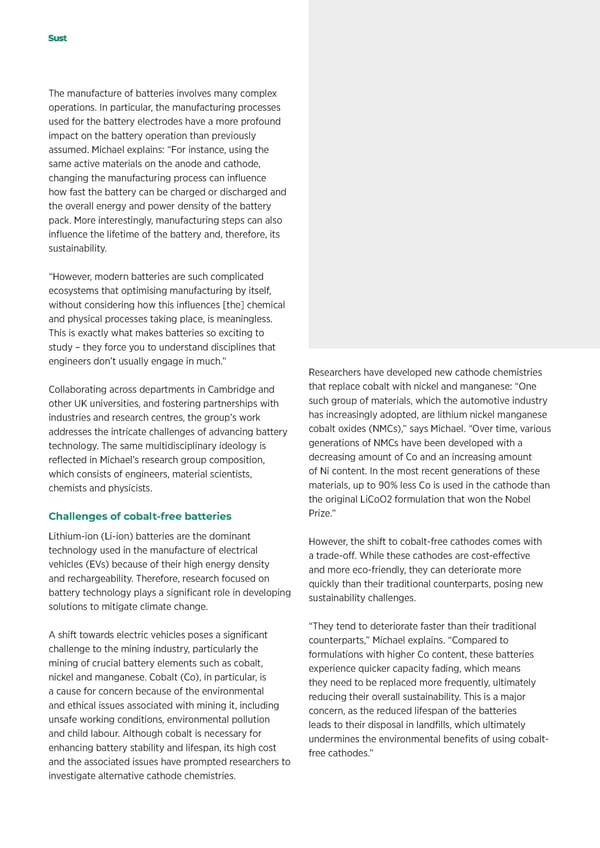SUSTAINABILITY SPOTLIGHT | 22 The manufacture of batteries involves many complex operations. In particular, the manufacturing processes used for the battery electrodes have a more profound impact on the battery operation than previously assumed. Michael explains: “For instance, using the same active materials on the anode and cathode, changing the manufacturing process can in昀氀uence how fast the battery can be charged or discharged and the overall energy and power density of the battery pack. More interestingly, manufacturing steps can also in昀氀uence the lifetime of the battery and, therefore, its sustainability. “However, modern batteries are such complicated ecosystems that optimising manufacturing by itself, without considering how this in昀氀uences [the] chemical and physical processes taking place, is meaningless. This is exactly what makes batteries so exciting to study – they force you to understand disciplines that engineers don’t usually engage in much.” Researchers have developed new cathode chemistries Collaborating across departments in Cambridge and that replace cobalt with nickel and manganese: “One other UK universities, and fostering partnerships with such group of materials, which the automotive industry industries and research centres, the group’s work has increasingly adopted, are lithium nickel manganese addresses the intricate challenges of advancing battery cobalt oxides (NMCs),” says Michael. “Over time, various technology. The same multidisciplinary ideology is generations of NMCs have been developed with a re昀氀ected in Michael’s research group composition, decreasing amount of Co and an increasing amount which consists of engineers, material scientists, of Ni content. In the most recent generations of these chemists and physicists. materials, up to 90% less Co is used in the cathode than the original LiCoO2 formulation that won the Nobel Challenges of cobalt-free batteries Prize.” Lithium-ion (Li-ion) batteries are the dominant However, the shift to cobalt-free cathodes comes with technology used in the manufacture of electrical a trade-o昀昀. While these cathodes are cost-e昀昀ective vehicles (EVs) because of their high energy density and more eco-friendly, they can deteriorate more and rechargeability. Therefore, research focused on quickly than their traditional counterparts, posing new battery technology plays a signi昀椀cant role in developing sustainability challenges. solutions to mitigate climate change. A shift towards electric vehicles poses a signi昀椀cant “They tend to deteriorate faster than their traditional challenge to the mining industry, particularly the counterparts,” Michael explains. “Compared to mining of crucial battery elements such as cobalt, formulations with higher Co content, these batteries nickel and manganese. Cobalt (Co), in particular, is experience quicker capacity fading, which means a cause for concern because of the environmental they need to be replaced more frequently, ultimately and ethical issues associated with mining it, including reducing their overall sustainability. This is a major unsafe working conditions, environmental pollution concern, as the reduced lifespan of the batteries and child labour. Although cobalt is necessary for leads to their disposal in land昀椀lls, which ultimately enhancing battery stability and lifespan, its high cost undermines the environmental bene昀椀ts of using cobalt- and the associated issues have prompted researchers to free cathodes.” investigate alternative cathode chemistries.
 Sustainability Spotlight Magazine Page 21 Page 23
Sustainability Spotlight Magazine Page 21 Page 23